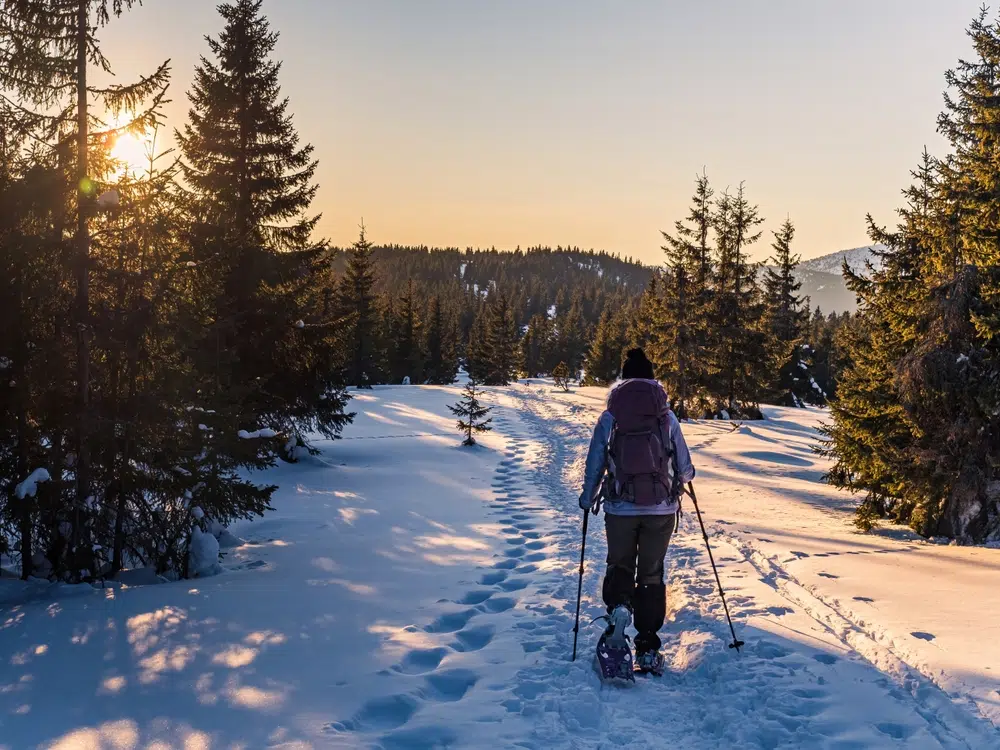Selecting the right size of snowshoes is crucial to enjoying your winter adventures. Snowshoes help distribute your weight over a larger area so your foot doesn’t sink completely into the snow – a phenomenon known as “flotation.” This article explains how to size snowshoes for beginners based on weight, snow conditions, and the terrain. After reading our snowshoe size guide, you’ll be prepared for snowshoe rentals and equipped with the knowledge to make the most of your winter adventures.

Snowshoes are typically measured in inches, and the length of the snowshoe affects how much flotation it provides. What length of snowshoes do I need? The main sizes available usually range from 20 inches to 36 inches. Generally, the heavier the person or, the lighter and deeper the snow, the longer the snowshoe is needed.
The most important factor in choosing the size of your snowshoes is your weight, including any gear you might be carrying. Most manufacturers provide a recommended weight range for each size of snowshoe. Here’s a general guideline on how to measure for snowshoes:
For kids, it’s essential to consider their weight and height when selecting snowshoes. Many manufacturers offer specific snowshoe sizing charts tailored for children’s snowshoes, ensuring a safe and comfortable fit for their winter adventures.
It’s vital to consider the total weight you’ll be carrying, as failing to do so can result in inadequate flotation and a more strenuous trek.
What size of snowshoe to get for different snow conditions? The type of snow you plan to walk on also affects the size of the snowshoe necessary. For powdery snow, you’ll need larger snowshoes to stay afloat. Conversely, if you are walking on packed, wet snow, you can opt for smaller snowshoes.
The type of terrain you will be exploring impacts your shoe choice from the snowshoe sizing chart as well. Flat terrain doesn’t require many additional features, but if you are heading into mountainous or icy areas, you may need snowshoes with better traction and optional tails for extra flotation.
In addition to size, various design features can greatly improve your snowshoeing experience. Each part of a snowshoe has a specific role that enhances performance and affects snowshoe sizing. Here are more details about these key features:
The materials used in snowshoe frames and decking are crucial for men’s and women’s snowshoe sizing and performance. Lightweight aluminum frames provide durability without extra weight, making maneuvering through snow easier. The decking, often made from tough synthetic materials like Hypalon or polyurethane-coated nylon, resists tearing and stays flexible in cold temperatures. The size of the frame and decking affect flotation—larger ones are needed for deep snow.
Bindings are vital for a secure and comfortable fit, crucial for men’s and women’s sizing snowshoes, which are designed to accommodate narrower feet. Adjustable bindings that can secure various boot sizes influence the snowshoe sizing to ensure it supports the user properly, especially in challenging conditions.
Crampons and traction systems ensure safety by gripping ice and packed snow, improving traction. The size and type of crampons can determine the necessary snowshoe sizing—larger or more aggressive crampons may be needed for tougher terrain, affecting the overall snowshoe size.
Selecting the right-sized snowshoe is essential for comfort and performance during winter activities. Here are detailed instructions on what size snowshoes to get, including advice on fitting and testing them in various conditions.
By incorporating these tips into your decision-making process, you’ll be better equipped to choose the right size and type of snowshoes for your winter explorations, ensuring maximum comfort, safety, and functionality.

This is a common question asked by everyone who wants to take up winter sports. Choosing the right size and type of snowshoe can greatly improve your snowshoeing experience. To determine the correct snowshoe size, consider your weight, the snow conditions, and the terrain. Whether you’re crossing flat snowy fields or tackling icy mountain paths, there’s a snowshoe that fits your needs.
At Carvers Ski+Bike, we know how crucial the question “What size snowshoes should I get?” is. As a family-owned business with over 28 years at the same location, we offer deep expertise and a personal touch. We carry top brands to ensure everyone, from beginners to seasoned pros, finds what they need. Trust Carvers Ski+Bike to equip you for your next winter adventure with our commitment to quality and service.
For someone weighing 250 lbs, you should look for snowshoes that are 30 inches or larger. These sizes provide enough surface area to ensure adequate flotation in most snow conditions, allowing for a smoother and less strenuous walk.
If you’re unsure, it’s generally better to size up in snowshoes. Larger snowshoes offer more flotation in deep snow, which is crucial for maintaining ease during your trek. However, overly large snowshoes might be cumbersome in densely wooded areas.
Snowshoes should fit your boots snugly without causing any slipping or movement. The bindings should be easily adjusted and tightly secured around your boots, ensuring your foot doesn’t shift while walking.
If snowshoes are too big, they can make walking cumbersome and tiring, especially in narrow areas. Oversized snowshoes can catch on vegetation or trip you up on uneven terrain. They may also be harder to maneuver, making climbs more difficult.